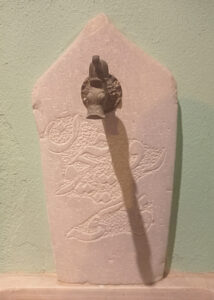A Muslim gravestone
City
Migration Period
Category
Full Description
Until 1912, there were several Muslim cemeteries scattered all over Thessaloniki: one outside Yedi Kule, three small ones in Ano Poli, one by the eastern walls on what is the current location of the city’s YMCA. The largest one was in the west, outside the gate called Litaia Pyli (today, the intersection of Agiou Dimitriou Street and Stournara Street). It was located next to Mevlevihane, where today we find two elementary schools, the 59th and 61st, opposite the church of Panagia Faneromeni on Klavdianou Street. Many graves, mainly of dervishes and sheiks, could also be found in the courtyards of mosques, mausoleums and tekkes (dervish monasteries), as well as in house gardens. After the population exchange of 1923, Muslim cemeteries were designated exchangeable properties and their ownership was granted to the Greek state, which, in turn, sold them as plots of land. At the same time, many Muslim cemeteries were looted and the gravestones were used as materials for construction, or even decoration, as is the case with the fountain depicted in the photograph, which was found in a house on Sachtouri Street in Ano Poli. Today, there are no Muslim cemeteries in Thessaloniki and the dead are usually buried in one of the Muslim cemeteries of Thrace.

